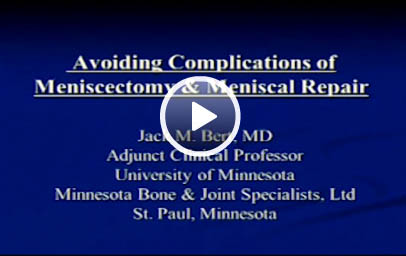
FEATURED VIDEO:
Avoiding Complications of Meniscectomy and Meniscal Repair
Submitted by: Jack M. Bert, MD (2/16/2012 10:55:00 AM).
Indications: To Repair or Not Repair
ORTHOSuperSite Video 2/16/2012 10:22:00 AM
Donald H. Johnson, MD, FRCSC
Case Presentations: Articular Cartilage Lesions and Treatment Options
ORTHOSuperSite Video 2/16/2012 9:29:00 AM
Jack M. Bert, MD; Nicholas A. Sgaglione, MD; William R. Beach, MD
Articular Cartilage Surgery
ORTHOSuperSite Video 2/15/2012 11:07:00 AM
Jack M. Bert, MD; Nicholas A. Sgaglione, MD; William R. Beach, MD
What is a Stinger (OR Nerve Pinch Injury)? Evaluation, Treatment and Return to Play
ORTHOSuperSite Video 2/1/2012 11:33:00 AM
John D. Kelly, MD
Panel Discussion: Neurological Issues on the sideline – You make the call
ORTHOSuperSite Video 2/1/2012 11:15:00 AM
David A. Wong, MD, MSc, FRCS(C); John D. Kelly, MD
Update on Concussions: What an Orthopedist Should Know
ORTHOSuperSite Video 1/31/2012 10:07:00 AM
David A. Wong, MD, MSc, FRCS(C)
Optimizing Primary Instability Success
ORTHOSuperSite Video 6/28/2011 2:18:00 PM
William N. Levine, MD
AC Joint Reconstruction: Weaver Dunn is History!
ORTHOSuperSite Video 4/27/2011 9:34:00 AM
Christopher S. Ahmad, MD
Anterior Instability: Technical Pearls
ORTHOSuperSite Video 4/26/2011 12:02:00 PM
Evan L. Flatow, MD
